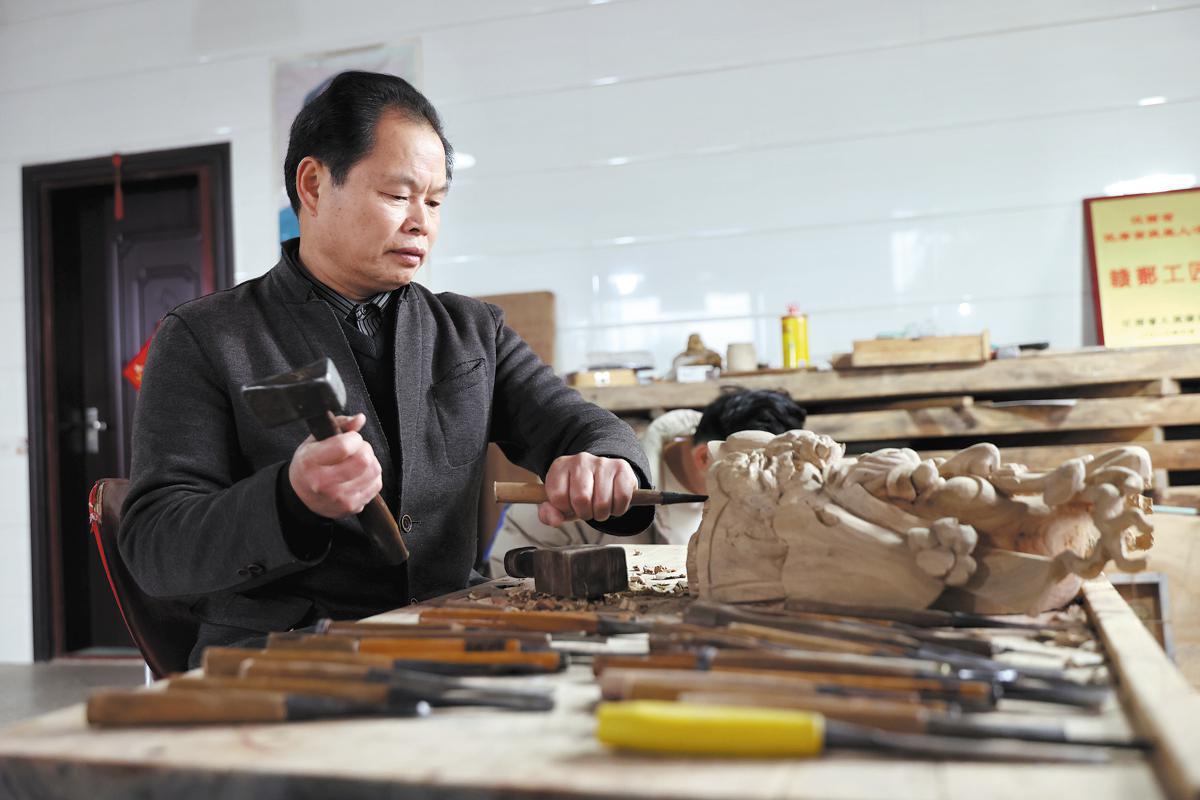Master teaches mask carving to students
China Daily, January 14, 2025 Adjust font size:

Thousands of years ago, across many parts of the vast Chinese landscape, people would perform an elaborate ceremony as part of a magical ritual to expel evil spirits.
As far back as the Shang Dynasty (c. 16th century-11th century BC) participants would don carved masks made of bone and shells and chant "nuo, nuo" to drive away the devil. Though a lot has changed since then, a special class in Lashi Middle School in Pingxiang, Jiangxi province, is taught where students can learn how to recreate these Nuo masks.
They draw outlines on a pumpkin or melon, then carefully carve out the eyes, nose and mouth. Their teacher, 59-year-old Peng Guolong, is one of the first-generation inheritors of Nuo mask carving at the China Nuo Culture Inheritance and Protection Base.
Peng said these exercises are essential for anyone who wants to be a Nuo mask maker. "Whenever I get a chance, I come to teach, starting with simple carving exercises and sometimes even using clay for practice. The kids are really into it," he said.
"Nuo is our traditional culture in Pingxiang. When we were young, we danced the Nuo dance. But it's hard to pass it on."
The good news is that Nuo masks, known for their intricate designs, are gradually gaining popularity in the market, according to Peng. "These days, they aren't often used in rituals, but many people buy Nuo masks to display at home as art. I've got a bunch of them in my house, too," he said.
Peng is a master in making Nuo masks and has dedicated himself to the field for over 30 years.
The mask maker's home is decorated with a stunning display of Nuo masks on the walls: an imposing red face, the black face of a general or a kind-looking white face representing a prime minister. "I first discovered painting when I was 8. By the time I was 13, my father had taught me the arts of oil painting, Nuo mask carving and embroidery," Peng said.
At 25, he was hired by a company in Guangzhou, Guangdong province, to work in painting and design. In 1996, Peng returned to his hometown to establish a Nuo mask carving factory. "I have a deep passion for Nuo carving, and it is my lifelong pursuit," he said.
Among those masks collected by Peng is an impressive piece of his won — a mask resembling a Tang Dynasty (618-907) general. "I've named it Ancient Nuo Greeting Guests," he said. "This piece took more than two months to sculpt and complete."
Made in 2008 for the Shanghai World Expo, the mask features two dragons playing with a ball and surrounded by Nuo dancers, all carved from a single piece of wood.
"Camphor wood is the main material used to make Nuo masks. It is chosen for its insect-repelling properties and symbolizes 'welcoming wealth'," Peng said.
Making a Nuo mask is no easy job. It involves seven key stages: selection, measurement, initial carving, detail carving, final carving, polishing and painting.
"The most intricate step is carving. It's a delicate job. Carving the round bead in a dragon's mouth can take several days," he added.
"Traditional Nuo masks can be quite intimidating. I've adopted a more rounded carving style to appeal to younger audiences."
At the 2010 Poyang Lake Ecological Festival held in Nanchang, capital of Jiangxi, Peng's Nuo masks were a huge success, selling out immediately, and even the masks he created on the spot were preordered by customers.
Since then, his Nuo masks have gained popularity in cities such as Guangzhou in Guangdong province, Shanghai, Hong Kong and Beijing, and have even been exported to the United States and Japan.
"At that time, I made over 100,000 yuan ($14,000) a year. One of my masks, Zhong Kui Eating the Ghost, was sold to a painter in Beijing for 20,000 yuan," Peng said.
He has been honored as one of the first Nuo Mask Carving Heritage Inheritors at the Nuo cultural heritage protection base, recognized as a Folk Craft Artist in Pingxiang, and awarded the title of highly skilled talent in the city's Xiangdong district.
Peng believes that ancient skills can only be inherited by passing them on to younger generations. So far, he has trained 30 apprentices.
"If my skills in making masks are lost, my life will have been wasted. So, I will pass them on to my apprentices and my sons, hoping they will continue the tradition," he said.
Some of his apprentices have established their own Nuo mask studios, while others are continuing their education under Peng's mentorship. As the demand for Nuo masks grows, he is embracing a larger volume of orders. For him, handmade production can no longer meet the increasing market demand.
"I hope that in the future, with the help of factories, we can increase production and allow more people to discover and appreciate Nuo masks."